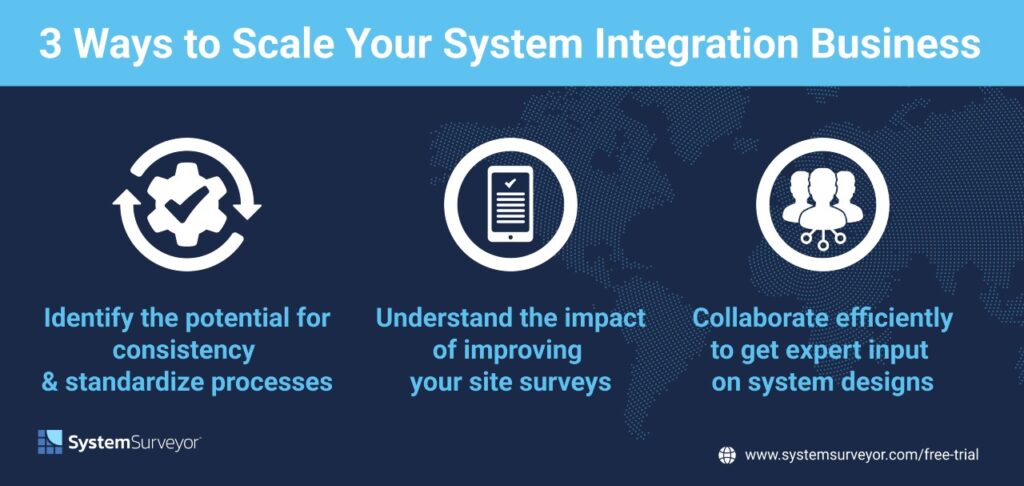In this next post, I’m excited to talk about scaling up a business. As the growth leader for our company, it’s on my mind every day. Let’s look at it through the lens of a system integrator for some pragmatic ways to achieve scale. (We also have a webinar on this topic! Click here to access.)
First off though, it is much harder to scale up if there is not a good amount of demand. The good news for system integrators in physical security is that there is growth potential everywhere. Three observations:
- Physical security systems are in high demand globally. The segment is estimated to evolve from $126.8 billion in 2022 to around $206 billion by 2030. That’s more than 150% growth in a span of 8 years.
- High activity of mergers and acquisitions in the system integrator business provide an opportunity for customers to look around (this is good and bad news). When M&A goes right, scale happens.
- Many organizations need to refresh their tech and cameras, especially to support emerging AI and machine learning applications. Customers are looking for modernization, potentially faster than their normal upgrade cycle. The system integrators who can confidently and proactively rise to meet this need are in a great position.
These and other factors converge in a way that we haven’t seen in decades, if ever. This creates an opportunity for system integrators to scale and grow — but only if they’re on the front edge of better processes, innovation and change.

3 Techniques for Scaling Your System Integration Business
As I was working with our team on this post, I went back to a couple of our recent case studies.
The one that spurred the idea to dig into scalability is the forward-looking focus by our friends at Prosegur Security. As more recent entrants into North America, they are looking at doing it right in order to scale. As Jim Fairbanks shared:
“While AutoCAD has been a standard tool, its complexity limited its effective use to a small group of specialists,” Fairbanks explained. “To scale our business, we recognized the need for a user-friendly, web-based platform that could be quickly mastered by any salesperson.”
What a smart thought. If you create a bottleneck that only a very small group of people can design electronic security systems, there will be a challenge scaling a company. We hear this time and again that there is a significant bottleneck to get out quality designs and proposals to capture the sales. What an opportunity to look under the covers. So, let’s start with #1.
1. Identify the potential for consistency and standardize those processes
First, as with any business, look carefully at the processes and workflows in use across your organization. For many system integrators, there is no single process — there’s just whatever series of steps each employee chooses to use. This is particularly prevalent in the early part of the sales process.
That isn’t a scalable approach: it requires every new hire to train under someone, learn all the exceptions and unwritten rules, and eventually form their own version of the process. The time to value for new salespeople is measured in years, not months or weeks.
Many processes can be systematized and documented. Doing so will increase efficiency across the organization, not to mention accuracy — when everyone follows the same set of steps in the same order, it’s much easier to recognize when something gets skipped.
Be like Jim at Prosegur Security and identify barriers to growth. What are your barriers? They may be much more evident than you realize. Ask yourself or your group these questions:
- Do we have a defined qualification and initial information and requirements gathering process with a customer or prospect?
- When do we need more detailed engineering design and which one’s are more straightforward?
- Where does the bottleneck happen for designs and proposals that take weeks and what’s the root cause?
Many system integrators have found that the very first step of the customer journey, the site survey, is at the root with profound implications on the downstream process and scalability.
2. Understand the impact of improving your site surveys (Hint: not doing so crushes scalability)
You’re not selling commodity items. As an integrator, your design work is key to the value you provide so it’s vitally important.
But for most companies, the site survey that informs a good quality design needs an extreme makeover. That is not to say it needs to be complex. The typical pen-and-paper site survey relies on handwritten notes and smartphone photos that lack detail and context. When the employee who did the site survey gets back to the office, details are already being lost. For the companies that use a wide variety of construction or Visio tools find the same issues. Everyone does this differently.
So, guess what happens? The engineering or estimation team redoes the work and goes back out. Talk about crushing scalability. And, the requests for design help pile up fast. Next thing you know, it’s taking weeks for everyone on the team to get out a decision-ready design and proposal. You lose business to competition. It’s a slippery slope.
You get the pain. So, let’s paint a different picture for you.
Imagine if every single sales person (even with limited experience) does the following, every. single. time:
- Imports digital floor plans or uses Google Maps with a scale (no floor plan? see suggestions)
- Drag-and-drops icons for potential locations for devices
- Captures photos that are IMMEDIATELY associated to the site/survey and device without more work on it
- Synchs and shares the initial information gathering with the design and estimating team
- Asks for collaborative help as needed with a key manufacturer partner NOT by emailing a scratched up PDF markup but by inviting them into the digital design and floor plan.
With those 4-5 process updates, many key things happen to improve scalability.
Your team:
- Impresses the prospect with a quality site survey and needs gathering process.
- Shaves hours off the transfer of information to get efficient design and engineering assistance.
- Initiates the automation of the design and bill of materials for refinement.
- Creates an opportunity for much better, precise collaboration with experts from your team and manufacturers.
- Moves to a professional design and proposal in a day or two versus weeks. VITAL to scalability.
- Guarantees higher success for the implementation of exactly what was sold with photos and a closed loop process.
- Improves the profit margins of the project by not missing vital information.
With System Surveyor powering your site survey process, you gain the ability to create more accurate, more detailed system designs faster. You’ll need less back-and-forth with customers, and what you do need can happen more quickly because you’re both looking at the same centralized information, collaborating and building graphically in real time.
Put simply: if you can deliver a better proposal faster than the competition, you’ll win more of those proposals. That’s the power of System Surveyor.
3. Collaborate more efficiently to get expert input on design
“Collaboration” sounds like a fancy term. To make it more basic, in order to scale, your team needs to get expertise and inputs on their designs quickly and easily. Not only do few salespeople have decades of experience, even if they did there is new AI and cloud-based technologies coming fast and furiously.
The System Integrator who has a good relationship with their manufacturer partners has a leg up on their competitors. In fact, they want to help with your design – of course, they want to win the business too. But, sending back and forth emails with marked up, fuzzy PDFs only makes everyone involved frustrated. Moreover, your team may not be learning in the process.
A few key things for better collaboration to support scalability:
- Establish good relationships with the Sales Engineering team at your favorite manufacturers, they can be extremely helpful and highly experienced.
- Learn from your manufacturer partners rather they fully defer to them. That will give your company scale as your team builds their own expertise. Most importantly, your customers will notice! You’re the integrator after all.
- Ask your manufacturer to meet you in System Surveyor for a design review. Many of them like that they can more efficiently provide design input. Remember, they need to scale their efforts too so be their favorite to collaborate with!
Get this right and see your scalability improve.
Get Started with Site Survey & Design Consistency
System Surveyor’s digital system design platform brings consistency and standardization to the site survey and security system design process, enabling scalability as you grow your system integration business. It also delivers benefits throughout the customer journey, from initial point of contact to site survey to sales handoff to installation.
Ask a simple question: are we doing site surveys consistently across the board and what could happen if we did?
If you think it may make a difference, let us know how we can help.
The best way to see what System Surveyor is capable of is to schedule a free demo. Start your free trial today.
